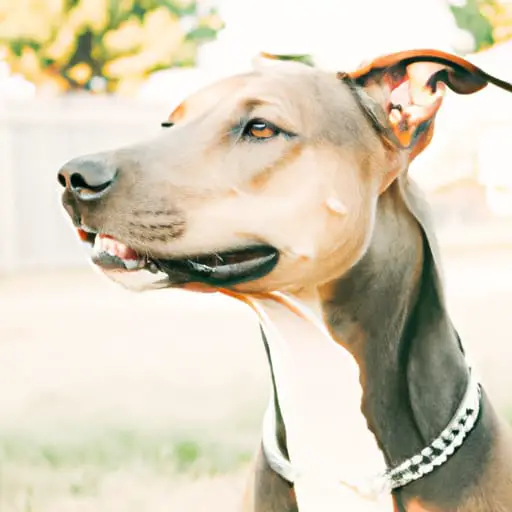Our website is supported by our users. We sometimes earn money when you click an affiliate link and make a purchase. This is at no extra cost to you and helps us to create quality content. Thank you for your support. For all that have shown us such wonderful support, we thank you from the bottom of our hearts!
Dog lovers are always on the lookout for new and unique breeds to add to their families. One such breed that has been gaining popularity in recent years is the Doberman Pitbull Mix. Also known as the Doberpit or Pit Pinscher.
These designer dogs combine the loyalty and protective nature of the Doberman Pinscher with the affectionate and playful nature of the American Pitbull Terrier, resulting in a dog that is both a great family companion and a loyal protector.
In this post, we will take a closer look at the Doberman Pitbull Mix, including its history, physical characteristics, temperament and training, health issues, grooming needs, and the costs associated with owning this breed.
We will also provide tips on finding a reputable breeder or adopting from a shelter, as well as some potential drawbacks to consider before adding a Doberman Pitbull Mix to your family.
Whether you are a first-time dog owner or an experienced dog lover, this post will provide you with all the information you need to determine if the Doberman Pitbull Mix is the right breed for you. So, let’s dive in and learn more about this unique and beloved breed.
History of Doberman Pitbull Mix
As mentioned, the Doberman Pitbull Mix is a relatively new designer breed that has been developed by crossing a Doberman Pinscher and an American Pit bull Terrier. The exact origin of this breed is not known, but it is believed to have originated in the United States in the early 2000s. The Doberman Pitbull Mix was developed to create a loyal and protective dog that is also a great family companion.
A little history on the Doberman Pinscher:

Karl Friedrich Louis Dobermann, often referred to as Louis Dobermann, was a German tax collector, dog breeder, and the founder of the Doberman Pinscher breed.
Due to his profession as a tax collector, Dobermann required a loyal and protective dog to accompany him during his rounds. With a vision to create a versatile working dog, he selectively bred several breeds, including the Rottweiler, Weimaraner, German Pinscher, and Greyhound, to develop a dog with exceptional intelligence, loyalty, and athleticism.
The result of his efforts was the Doberman Pinscher, a breed renowned for its courage, loyalty, and versatility. Dobermann’s creation quickly gained popularity as a guard dog, police dog, and military dog, owing to its sharp instincts, strength, and trainability.
Today, the Doberman Pinscher remains a cherished breed worldwide, known for its elegant appearance and unwavering loyalty to its family. Karl Friedrich Louis Dobermann’s ingenuity and dedication to creating a remarkable canine companion have left a lasting legacy in the dog breeding community.
Dobermans have been given a poor image as a “bully breed” for a few different reasons, including the following:
- Their history of service in both the military and law enforcement.
- Because of their size and their occasionally aggressive nature, particularly with other dogs.
- Inadequate or nonexistent training
- Irresponsible breeding contribute to the perpetuation of this aggressive behavior.
A little history on the American Pitbull Terrier
The American Pitbull, often referred to as the American Pit Bull Terrier, has a rich and complex history. Developed in the United States during the 19th century, the breed descended from various terrier and bulldog types, originally bred for bull-baiting, bear-baiting, and other blood sports.
The early ancestors of the American Pitbull were known for their strength, tenacity, and agility. However, as blood sports were gradually outlawed, the breed’s purpose shifted towards more lawful activities such as farm work, hunting, and serving as loyal family companions.
During the early 20th century, Pitbulls gained immense popularity in America, symbolizing bravery and determination. They were often featured in advertisements, movies, and as mascots for various organizations. The breed’s versatility and intelligence also led them to excel in working roles, such as search and rescue, therapy work, and as service dogs.
Unfortunately, in recent decades, the American Pitbull has faced controversy due to its misuse in illegal dog fighting rings and irresponsible ownership. This negative association has led to breed-specific legislation in some regions.
It is important to note that responsible ownership, socialization, and proper training play crucial roles in shaping the temperament of any dog, including the American Pitbull. Despite their controversial reputation, many Pitbulls continue to be cherished family pets, valued for their loyalty, affection, and resilience.
Unfortunately, due to poor ownership and unscrupulous breeders, both the Doberman and any Pitbull mix breeds have a bad reputation.
Since they are hybrid dogs and not purebred dogs, they are not recognized by the American Kennel Club.
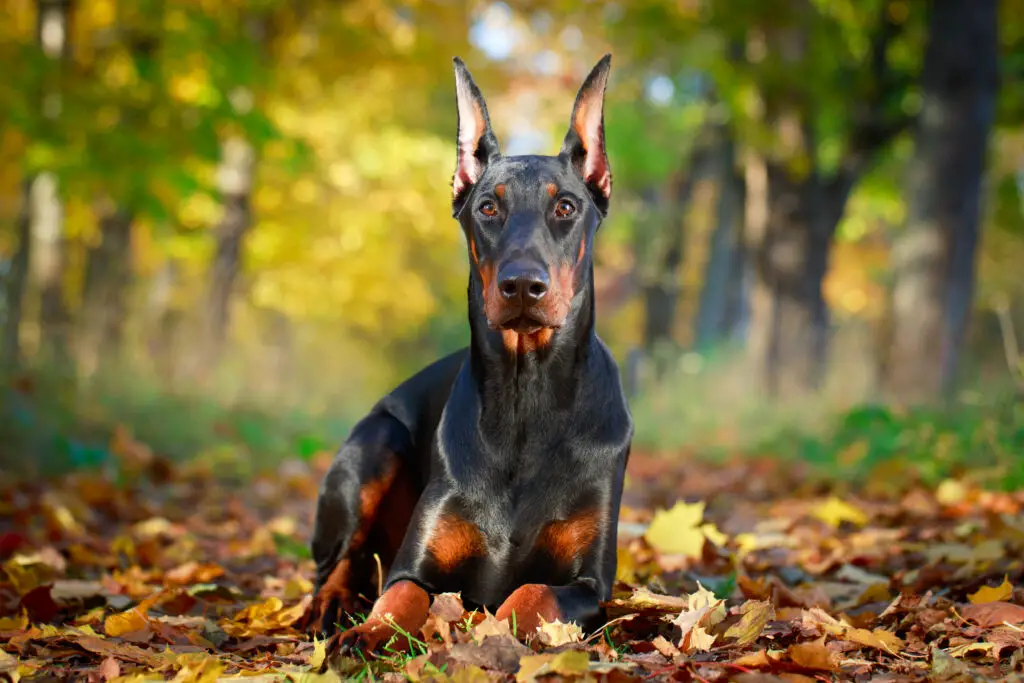
Physical Characteristics of the Doberman Pinscher
The Doberman Pinscher is a striking and well-built breed known for its imposing physical characteristics. These dogs are medium to large in size, typically standing 24 to 28 inches tall at the shoulder and weighing between 60 to 100 pounds, with males generally being larger than females.
Their bodies are muscular and lean, with a powerful and athletic build that exudes strength and agility. The Doberman’s coat is short, smooth, and typically comes in solid black, red, blue, or fawn colors, often with distinctive rust markings on their face, chest, legs, and tail.
One of the most prominent features of the Doberman Pinscher is its sleek and elegant head, which is wedge-shaped and adorned with a long, chiseled muzzle. Their ears are often cropped to stand erect, though many countries have banned this practice, and natural ears are more common.
The breed’s eyes are almond-shaped and dark, expressing alertness and intelligence. The Doberman’s tail is customarily docked, leaving it short and straight.
Overall, the breed’s appearance conveys a sense of power, grace, and keen watchfulness, making it a popular choice as both a working and family dog.

Physical Characteristics of the American Pitbull
The American Pit Bull Terrier, often simply referred to as the Pitbull, is a medium-sized, muscular breed known for its distinctive physical characteristics. These dogs typically stand between 17 to 21 inches in height at the shoulder and weigh around 30 to 60 pounds, with males generally being slightly larger than females. The Pitbull’s body is compact and well-muscled, with a strong and agile build that reflects its athletic nature. Their coat is short, glossy, and close-fitting to their body, which gives them a sleek and muscular appearance.
Pitbulls come in a wide variety of coat colors, including solid or mixed combinations of colors such as black, blue, brown, red, brindle, and fawn. These coats may have white markings or patches on their chest, face, and paws. Their head is broad, featuring a well-defined, slightly wrinkled, and powerful jawline. The breed’s eyes are round to almond-shaped, with an alert and intelligent expression, while their ears can be either cropped or left natural, standing erect when cropped or folded over when natural. The Pitbull’s tail is medium in length, tapering to a point, and carried low. Their overall appearance exudes strength, agility, and a sense of vigor, making them popular as both working dogs and loyal companions.
Physical Characteristics of the Doberpit
The DoberPit, can be a combination of any of the physical and temperamental traits of either the Doberman Pinscher or the American Pitbull. These mixed-breed dogs can inherit a wide range of physical characteristics, including varying coat colors and patterns, and may have a muscular and well-proportioned body with a sleek, glossy coat.
The specific traits of a DoberPit can vary significantly, but they generally exhibit a blend of strength, agility, and intelligence, which makes them versatile and highly trainable. In terms of temperament, the mix can display qualities such as loyalty, protectiveness, and a friendly disposition if socialized properly. They often make devoted family pets and are known for their affectionate nature, making them a great choice for those who are willing to provide them with the love, exercise, and training they need.
Temperament & Training of the Doberman Pitbull Mix
The Doberman Pitbull Mix is known for its loyal and protective temperament, which makes them wonderful family members, that can provide both companionship and security. They are an intelligent dog and easy to train, making it an good choice for first-time dog owners. They are smart and energetic dogs with high energy levels so they need plenty of exercise.
Proper training is important for the Doberman Pitbull Mix, as this breed can be stubborn at times. Positive reinforcement training methods, such as treats and praise, are recommended to encourage good behavior and obedience. Early and proper socialization is also important for the Doberman Pitbull Mix to ensure that it is comfortable around other dogs and people and curbs any aggressive tendencies.
Health Issues of the Doberman Pitbull Mix
As with all dog breeds, the Doberman Pitbull Mix may be prone to certain health conditions including heart disease. It is important to be aware of these potential health issues and to provide your dog with regular veterinary care. Here are some potential health issues to be aware of:
Parent 1: Doberman Pinscher
1. Dilated Cardiomyopathy (DCM):
Dilated cardiomyopathy is a serious heart condition that affects the Doberman Pinscher breed. DCM causes the heart muscle to become weak, leading to an enlarged heart and poor pumping efficiency. This condition can result in symptoms such as exercise intolerance, fatigue, coughing, difficulty breathing, and even sudden death. While the exact cause of DCM in Dobermans is not fully understood, it is believed to have a genetic component. Regular cardiac screenings, including echocardiograms and electrocardiograms, are recommended to detect early signs of DCM. Nutritional support and medications may be prescribed to manage the condition and improve the dog’s quality of life.
2. Von Willebrand’s Disease (vWD):
Von Willebrand’s Disease is an inherited bleeding disorder that affects the Doberman Pinscher breed. It is caused by a deficiency in von Willebrand factor, a protein necessary for proper blood clotting. Dogs with vWD may experience prolonged bleeding after injuries or surgeries, nosebleeds, excessive bleeding during heat cycles, or bleeding gums. Testing for vWD can be done through DNA testing or by measuring von Willebrand factor levels in the blood. While there is no cure for vWD, management typically involves avoiding situations that may lead to excessive bleeding and using clotting agents when necessary.
3. Wobbler Syndrome:
Wobbler Syndrome, also known as cervical spondylomyelopathy, is a neurological condition commonly seen in large and giant breeds, including Doberman Pinschers. It is characterized by the compression or instability of the cervical (neck) spinal cord.
Symptoms may include an unsteady or wobbly gait, weakness in the hind limbs, neck pain, and difficulty getting up or walking. Treatment options range from conservative management (rest, medication, physical therapy) to surgical intervention in more severe cases.
Proper nutrition, controlled exercise, and maintaining a healthy weight can help reduce the risk of developing or exacerbating Wobbler Syndrome in Dobermans.
These are just a few of the health concerns that can affect Doberman Pinschers. Responsible breeders focus on genetic testing and health screenings to minimize the risk of these conditions in their breeding lines. Regular veterinary check-ups, a balanced diet, exercise, and early detection through screenings are key to maintaining the health and well-being of Dobermans.
Parent 2: American Pitbull Parent
1. Hip Dysplasia:
Hip dysplasia is a common orthopedic condition in dogs, including American Pitbulls. It is characterized by an abnormal development of the hip joint, causing instability and eventually leading to arthritis and pain.
Pitbulls with hip dysplasia may exhibit lameness, difficulty rising or climbing stairs, and decreased activity levels. Regular exercise, maintaining a healthy weight, and avoiding excessive jumping and rough play during their growing stages can help reduce the risk of hip dysplasia.
screening tests such as hip X-rays can help identify dogs with this condition, and treatment options may include medication, physical therapy, or even surgical intervention.
2. Allergies:
American Pitbulls can be prone to allergies, which can manifest in various ways. Common types of allergies in Pitbulls include food allergies, environmental allergies (such as pollen or dust mites), and contact allergies (reaction to certain substances like certain fabrics or cleaning products).
Symptoms of allergies may include itching, redness, rashes, ear infections, and gastrointestinal issues. Identifying and avoiding the allergen, such as switching to a hypoallergenic diet or using allergy-specific medications or treatments, can help manage and alleviate the symptoms.
Consulting with a veterinarian is important to determine the exact cause and appropriate treatment for the specific allergy.
3. Ichthyosis:
Ichthyosis is a rare and inherited skin disorder that can affect American Pitbull Terriers. It is characterized by dry, thickened, and scaly skin, resembling fish scales. This condition is caused by a mutation in the gene responsible for maintaining skin integrity and moisture.
Pitbulls with ichthyosis may experience itching, flaking, and skin infections. While there is no cure for ichthyosis, symptomatic management involves regular bathing, moisturizing the skin, and using specialized shampoos or topical treatments recommended by a veterinarian.
It is important for owners to provide proper skin care and consult with a veterinary professional to ensure the comfort and well-being of their Pitbull affected by ichthyosis.
4. Cerebellar ataxia
Cerebellar ataxia is a neurological disorder that can affect certain breeds, including the Pitbull Terrier.
It is characterized by a lack of coordination and balance due to dysfunction or damage to the cerebellum, the part of the brain responsible for motor control.
Pitbulls with cerebellar ataxia may have a wobbly gait, stumble or fall frequently, have difficulty with precise movements, and display tremors or head bobbing.
This disease differs from Wobbler’s syndrome as a disease of the brain rather than the neck or spine.
This condition is typically genetic, and there is no known cure. Supportive care, physical therapy, and adapting the environment to minimize injury risks can help improve the quality of life for Pitbulls with cerebellar ataxia.
It is important for owners to work closely with a veterinarian to manage the symptoms and provide appropriate care for their affected Pitbull.
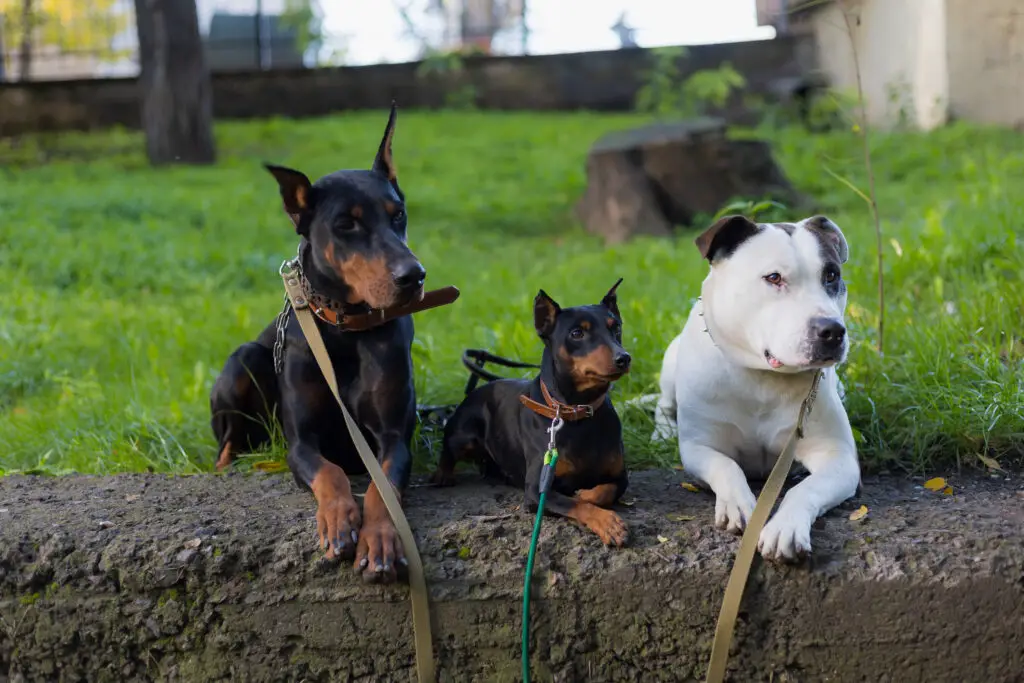
Grooming Your Doberman Pitbull Mix
The Doberman Pitbull Mix has a short, smooth coat that is easy to maintain. Here are some grooming tips for the Doberman Pitbull Mix:
Brushing: The Doberman Pitbull Mix should be brushed regularly to remove loose hair and debris. Luckily the Doberpit is not a heavy shedder. A slicker brush or comb can be used to remove loose hair and promote circulation.
Bathing: The Doberman Pitbull Mix should be bathed every 4-6 weeks to keep its coat clean and healthy. Be sure to use a mild, dog-specific shampoo that is free of harsh chemicals or fragrances that could irritate their skin like this Burt’s Bees for Dogs Oatmeal Dog Shampoo With Colloidal Oat Flour & Honey.
That said, if your dog is showing signs of allergies or ichthyosis be sure to take them to get checked out by your vet before bathing them with anything.
Cutting fur/hair: The Doberman Pitbull Mix may need to be trimmed or clipped every 6-8 weeks for general hygiene.
As for clippers, we purchased these and used them for years oneisall Dog Shaver Clippers Low Noise Rechargeable Cordless Electric Quiet Hair Clippers.
Clipping or Grinding nails: The Doberman Pitbull Mix’s nails should be trimmed regularly to prevent them from getting too long and causing discomfort or injury. A nail clipper or grinder can be used to trim the nails.
But first, check out our article on How to Grind Your Dog’s Nails Safely.
Dental care: The Doberman Pitbull Mix’s teeth should be brushed regularly to prevent plaque buildup and dental problems. A dog toothbrush and toothpaste should be used to brush the teeth.
If your Doberpit is resistant to having their teeth brushed, you can consider utilizing dental treats, chews, or toys to aid in the cleaning process.
One highly regarded option is GREENIES Original Regular Natural Dog Dental Care Chews, which you can find at this link: GREENIES Original Regular Natural Dog Dental Care Chews.
It’s important to note that these chews contain wheat and wheat gluten, which can potentially trigger allergies.
Another popular brand is the Nylabone Nutri Dent Natural Dental Chew Treats, available at this link: Nylabone Nutri Dent Natural Dental Chew Treats, and it also contains wheat.
Before offering any treats to your dog, it is crucial to carefully examine the ingredients. Experts have started to identify products with ingredients that may not be as beneficial for dogs as initially believed.
Currently, there is growing concern regarding potato and pea protein, as they are suspected to cause adverse reactions in some dogs.
As more information and research become available, it might be wise to minimize your dog’s exposure to these ingredients for the time being.
Cleaning ears: The Doberman Pitbull Mix’s ears should be checked regularly for signs of infection or irritation. A cotton ball and a gentle ear cleaner can be used to clean the ears.
Or, you can use these convenient ear wipes. These are compact and good for travel.
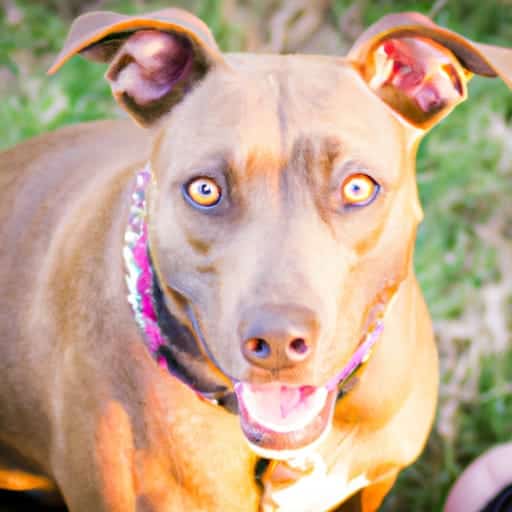
Owning a Doberman Pitbull Mix
Special traits
The Doberman Pitbull Mix is a unique breed with several special traits that make it a popular choice for dog lovers. Here are some of the special traits of the Doberman Pitbull Mix:
Loyal and protective: The Doberman Pitbull Mix is known for its loyalty and protective nature, making it an excellent choice for families and individuals who are looking for a dog that can provide both companionship and security.
Intelligent and trainable: The Doberman Pitbull Mix is a smart breed that is easy to train, making it an excellent choice for first-time dog owners.
Affectionate: The Doberman Pitbull Mix is a loving and affectionate breed that loves to be around people and is great with children.
Active: The Doberman Pitbull Mix requires regular exercise and activity to stay healthy and happy. This breed is not suitable for apartment living and prefers a home with a yard where it can run and play.
Cost of purchase
The cost of a Doberman Pitbull Mix can vary depending on several factors, including the breeder, location, and pedigree. On average, a Doberman Pitbull Mix can cost between $500 and $1,500. It is important to do your research and find a reputable breeder who is breeding healthy and well-socialized dogs.
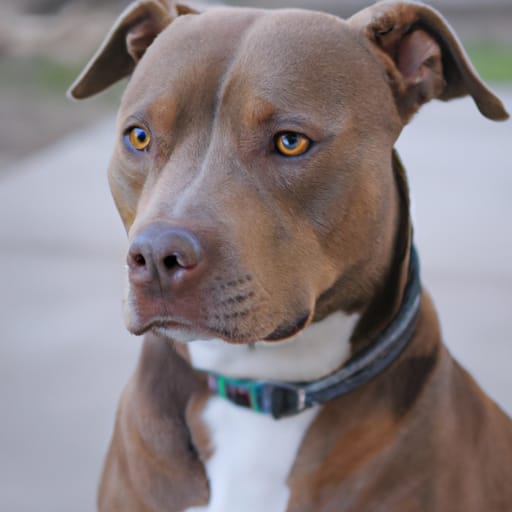
Maintenance costs
In addition to the initial cost of purchasing a Doberman Pitbull Mix, there are also maintenance costs to consider. Here are some of the maintenance costs associated with owning a Doberman Pitbull Mix:
Special training: If you plan to train your Doberman Pitbull Mix for specific tasks or activities, such as obedience training or agility training, there may be additional costs associated with specialized training classes or equipment.
Medical costs: Like all dogs, the Doberman Pitbull Mix may require regular veterinary care, including vaccinations, check-ups, and preventative care. In addition, if your dog develops any health issues, there may be additional costs associated with treatment and medication.
- Grooming costs: The Doberman Pitbull Mix’s coat requires regular grooming, which can add up over time.
- Food and supplies: The Doberman Pitbull Mix will require a regular supply of food, treats, and toys, which can add up over time.
Finding Breeders and Adopting from a Shelter
When looking for a breeder to purchase a Doberman Pitbull Mix from, it is important to do your research and find reputable breeders who are breeding healthy and well-socialized dogs. Here are some tips for finding a reputable breeder:
Research: Look for breeders who have a good reputation and positive reviews from past customers. You can also check with breed-specific organizations or clubs for recommendations.
Visit the breeder: It is important to visit the breeder in person to see the conditions in which the dogs are kept and to meet the puppies and their parents. This will give you a good idea of the breeder’s practices and the temperament of the dogs.
Ask questions: Don’t be afraid to ask the breeder questions about their breeding practices, the health of their dogs, and their socialization and training methods.
Health testing: Look for breeders who health test their dogs for genetic health issues and can provide documentation of the results.
Adopting a Doberman Pitbull Mix from a shelter is also a great option. Many shelters and rescue organizations have Doberman Pitbull Mixes available for adoption, and adopting from a shelter can be a great way to give a dog a second chance at a happy life.
Drawbacks of owning
While the Doberman Pitbull Mix is a popular and beloved breed, there are also some drawbacks to owning one. Here are some potential drawbacks to consider:
Exercise needs: The Doberman Pitbull Mix requires regular exercise and activity to stay healthy and happy. If you are not able to provide your dog with enough exercise and stimulation, they may become bored and destructive.
Health issues: As a hybrid breed, the Doberman Pitbull Mix may inherit some health issues from its parent breeds. It is important to be aware of these potential health issues and to provide your dog with regular veterinary care.
Grooming needs: The Doberman Pitbull Mix’s coat requires regular grooming, which can be time-consuming and expensive.
Breed-specific legislation: Some cities and municipalities have breed-specific legislation that restricts or bans certain breeds, including the Pitbull. It is important to be aware of any breed-specific legislation in your area before adopting a Doberman Pitbull Mix.
- Fun fact
Doberman Pitbull Mixes are often used as therapy dogs due to their loyal and affectionate nature.
FAQs on the Doberman Pitbull Mix
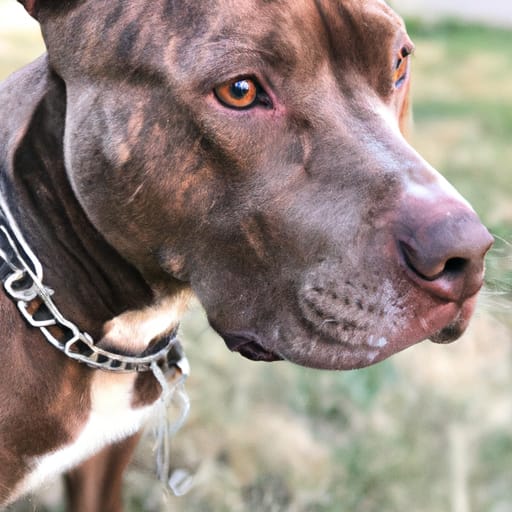
What is a Doberman Pitbull Mix called?
The Doberman Pitbull Mix is also known as a Pitbull Doberman Mix, Dober Pit, Pit Pinscher or a Pit Dob.
What is the personality of a Doberman Pitbull Mix?
The Doberman Pitbull Mix is known for its loyal and protective personality, as well as its intelligence and trainability. This breed is also affectionate and great with children, making it an excellent choice for families.
The Bottom Line on the Doberman Pitbull Mix
The Doberman Pitbull Mix is a unique and beloved breed that combines the loyalty and protective nature of the Doberman Pinscher with the affectionate and playful nature of the American Pitbull Terrier. This breed is intelligent, trainable, and great with children, making it an excellent choice for families and individuals who are looking for a loyal and loving companion.
However, it is important to be aware of the potential health issues and grooming needs of this breed, as well as the exercise and training requirements. If you are considering adding a Doberman Pitbull Mix to your family, be sure to do your research and find a reputable breeder or adopt from a shelter.
Overall, the Doberman Pitbull Mix is a wonderful breed that can bring joy, companionship, and security to your life for many years to come.
Please read our Legal Disclaimer

